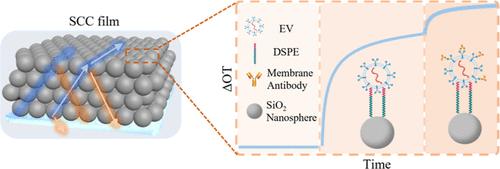基于有序孔层干涉法的细胞外囊泡实时分离和多功能检测
IF 6.7
1区 化学
Q1 CHEMISTRY, ANALYTICAL
引用次数: 0
摘要
细胞外囊泡(EVs)正逐渐成为临床治疗和液体活检的新工具。由于生物流体的复杂性和电动汽车的理化性质,电动汽车分离的生物活性、速度和效率往往不能令人满意。在这里,我们提出了一种实时分离来自细胞和尿液的ev的方法,使用有序多孔层干涉法,以二氧化硅胶体晶体薄膜作为传感衬底,实现了大于90%的效率。基于其实时监测的特点,在隔离过程中实现在线浓度检测功能。该技术以尿ev膜蛋白标记物为靶点,对前列腺癌液体活检具有较高的诊断价值。此外,我们比较了细胞和尿液中多种EV膜蛋白的表达和结合解离动力学数据。总之,这种多功能方法为各种体液的EVs快速分离、浓度检测、药物靶点筛选和液体活检提供了一种新的策略。本文章由计算机程序翻译,如有差异,请以英文原文为准。

Real-Time Isolation and Versatile Detection for Extracellular Vesicles Based on Ordered Porous Layer Interferometry
Extracellular vesicles (EVs) are progressively becoming novel instruments for clinical therapeutics and liquid biopsies. Due to the complexity of biofluids and the physicochemical properties of EVs, the biological activity, velocity, and efficiency of EV isolation are always unsatisfying. Here, we present a real-time isolation approach of EVs derived from cells and urine using ordered porous layer interferometry with a silica colloidal crystal film as the sensing substrate, achieving efficiency greater than 90%. The online concentration detection function is performed during the isolation process on the basis of its real-time monitoring characteristic. Using membrane protein markers of urine EVs as targets, this technique has a high diagnostic value for liquid biopsy of prostate cancer. Furthermore, we compared multiple EV membrane protein expression and binding dissociation kinetic data from cells and urine. In summary, this multifunctional approach provides a novel strategy for the rapid EVs isolation, concentration detection, drug target screening, and liquid biopsy of various body fluids.
求助全文
通过发布文献求助,成功后即可免费获取论文全文。
去求助
来源期刊

Analytical Chemistry
化学-分析化学
CiteScore
12.10
自引率
12.20%
发文量
1949
审稿时长
1.4 months
期刊介绍:
Analytical Chemistry, a peer-reviewed research journal, focuses on disseminating new and original knowledge across all branches of analytical chemistry. Fundamental articles may explore general principles of chemical measurement science and need not directly address existing or potential analytical methodology. They can be entirely theoretical or report experimental results. Contributions may cover various phases of analytical operations, including sampling, bioanalysis, electrochemistry, mass spectrometry, microscale and nanoscale systems, environmental analysis, separations, spectroscopy, chemical reactions and selectivity, instrumentation, imaging, surface analysis, and data processing. Papers discussing known analytical methods should present a significant, original application of the method, a notable improvement, or results on an important analyte.
 求助内容:
求助内容: 应助结果提醒方式:
应助结果提醒方式:


